Pool of Radiance: Ruins of Myth Drannor Updated Preview
Mattel has undergone some changes in the last few months--we find out if they've affected the game at all.
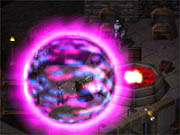
Pool of Radiance: Ruins of Myth Drannor promises to not only resurrect the gold box series of Dungeons & Dragons games but also to be the first D&D game based on the 3rd Edition Dungeons & Dragons rules. Baldur's Gate II is already the high standard for all D&D role-playing games, as well as RPGs in general. Can Pool of Radiance II follow up BioWare's effort and deliver as successful a D&D role-playing experience? Developer Stormfront Studios and publisher Ubi Soft definitely think so.
GameSpot has brought you several Pool of Radiance II previews in the past year, but recently we visited the offices of publisher Ubi Soft to check on the status of Pool II and see how the game has progressed so far. At this point, the team is fairly confident of a June 2001 release date. In fact, much of the game is finished, and we saw the final battle and endgame cutscene. All the movies are finished, all the quests have been completed, and at this point, what remain to be done are game balance and optimization. We won't spoil the story, but the game definitely has an epic ending.
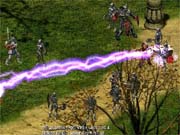
According to Chuck Yager, the associate producer for Pool of Radiance, the game is huge. We detailed the more than half dozen different areas in the game in our previous previews, and they are indeed large. However, because the entire game takes place in a fairly compact, ruined city, there won't be as much walking around, as in Baldur's Gate--although within this city there are many spacious areas and dungeons. The effect results in more jam-packed areas to explore, but less dead space to walk through. Yager has played through the entire game at least once and says that the game has at least 60 to 70 hours of gameplay. If you rush through the game, playing only the major quests and ignoring the side quests, you should have around 60 hours of gameplay to satisfy you. However, if you choose to hunt for every side quest and there are more than 50, the projected gameplay shoots up to 100 hours or more. If anything, the designers are looking to make Pool II the most densely packed of all D&D RPGs and should give Baldur's Gate II some competition in the length and value department.
As we reported previously, Pool of Radiance's multiplayer mode will be a hack-and-slash dungeon crawl through randomly generated dungeons, although the actual tile sets of the random dungeons are the same ones used to build the single-player game. You'll still adventure through Myth Drannor, but the particulars of the ruined city will be randomly generated to give you a feel that is different from the single-player game. As for the size of these randomly generated dungeons, Yager says that each tile is two screens by two screens and that there will be at least six tiles per dungeon, resulting in some rather large environments. Yager also says that in multiplayer, there will be 90 or so unique items that you won't find in single-player. In addition, there will be new creatures in multiplayer--ones that you won't fight in single-player. These creatures are based on the single-player models but have enhanced stats and perhaps a few tweaks in terms of graphics. Yager refers to them as minibosses, and they will often be the final obstacle to obtaining those many unique items.
Quests
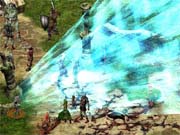
Because the game is so close to completion, we were able to get a closer look at some of the quests presented in the game. There are minor spoilers on this page--they explain the back story behind some of the quests, but they do illustrate examples of the kinds of tasks you'll have to complete to win the game.
One of the main characters in the game is Anorrweyn Evensong, the ghost of an elfin maiden. She is actually involved in several quests. She holds vital information regarding how the new pool of radiance came into being and how to destroy it. However, her existence in the physical plane is tenuous, so you'll have to quest items that can strengthen her hold on reality. You'll have to find a token of magic power that will bring her spirit back to the world. Once you do that, you'll find that her place of rest begins to shine with some of the luster it had when Myth Drannor was still thriving. Prior to finding the token, you'll find her place of rest is ruined, with battered pillars and fallen statues. But once the token is recovered, shimmering ghost images of the fully restored area appear, superimposed over the real ruins. The graphics do a good job of creating a glowing re-creation of the old temple over the gritty new ruins. However, although the magic energies, as represented by the newly restored images of the old Myth Drannor, are strengthened, Anorrweyn tells you that she is not yet completely grounded and needs you to recover her skull and bring it back to her resting place. Once you do that, she'll be strong enough to help you.
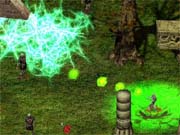
Another quest involves destroying the spawned pools, which have appeared all over Myth Drannor as a side effect of the existing pool of radiance. These spawn pools are breeding pits for evil and look like bubbling miniature volcanoes. They attract evil creatures to the areas they infest and corrupt the surrounding environments. As you destroy the spawn pools, you'll uncover magic items and free the polluted areas. For example, one spawn pool has infested the water pumps of an old dwarven stronghold, destroying the pumps and drying up the wells. Once you destroy the spawn pool, the water pump system will be restored, and you'll be able to return here throughout the game to drink its restorative waters and get free healing.
One quest we saw had little to do with the overall story of the game and was one of the higher-level side quests in Pool of Radiance. The quest was to retrieve the demon rivener, a powerful +5 magic greatsword. It gets a +7 bonus for attacking dragons and dragonkin, and it can cast a flamestrike spell at the 20th level. The flamestrike is a powerful spell that can incinerate nearly anything with holy fire. It is one of the strongest weapons in the entire game. To retrieve it, though, you need to find the tomb of a war hero and restore a gem to that tomb. Once you do that, the war hero will give you a magic word that will open a closed chamber. At the time, you won't know what this magic word does, but as you explore more of the dungeons, you'll come across a locked chamber that can be opened only by the word you've been carrying around with you. But just speaking the word and opening the chamber is not enough--you'll need to defeat the sword's demonic guardians, who can obliterate even high-level characters in mere seconds.
Game Mechanics
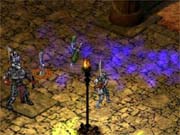
The world of 3rd Edition D&D differs in quite a few respects from the 2nd Edition D&D we're used to in games such as Baldur's Gate II and Icewind Dale. All classes have their usual abilities--like the ability to turn the undead for the cleric or better attacks and hit points for the fighter--but one big difference is that characters now have more special abilities and capabilities. For instance, every character now gets to learn feats every three levels. Some feats even let you perform special attacks. For instance, if you learn the cleave feat, you get a bonus attack against any adjacent enemy any time you land a killing blow against an enemy. In effect, your attack is so powerful that you cut through your first target and continue on to slice his buddy standing next to him. Another feat is point blank shot, which gives you an attack and damage bonus with your ranged attacks when you shoot an enemy at close range. Other feats are passive, giving you constant bonuses. One feat, called improved initiative, gives you a bonus to your initiative roll before each combat. Unlike Baldur's Gate II, Pool of Radiance has turn-based combat, so each character has to go in order. Before each combat, your characters and the enemies all roll for initiative, basically rolling to determine who goes first. The improved initiative bonus often lets you act before the next character's turn. Other feats are defensive in nature, giving you bonuses on your saving throws to resist magical attacks. There will be about 17 feats in total, and each class will have its own feat list, although there is a lot of overlap in the lists.
In addition, the game will feature eight to nine skills, many of which are used by the thief. Skills include hiding, spotting and listening (for noticing hidden enemies), searching for traps, disabling traps, healing, and concentration. The last skill, concentration, is a new concept to D&D. Gamers will note that in 2nd Edition games, like Baldur's Gate II, the spell automatically fails if you get hit while casting. But now you can roll a concentration check, and if you succeed, you can still cast the spell despite getting hit.
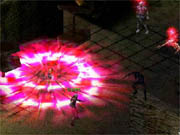
Combat in 3rd Edition D&D is also more tactical than combat in 2nd Edition Dungeons & Dragons. Now, concealment and cover need to be taken into consideration. For example, if your ranger fires a bow from around a corner, he gets a cover bonus to his armor class, making him harder to hit. In essence, the cover bonus reflects the archer's ability to fire an arrow and then duck back behind the corner to cover his body from retaliatory attacks. Or if you attack from darkness or dense foliage, you'll get a concealment bonus, which means attacks aimed at you might miss outright due to your concealment. You can also get flanking bonuses if you attack an enemy from opposite sides. Other tactics you can try in combat now include refocusing, which lets you assess the combat situation and then gain a bonus to initiative, effectively letting you attack first from then on. In Pool II's initiative-ordered turn-based combat system, acting first is often a huge advantage.
Classes
One of the benefits of using the new 3rd Edition rules is that there are now some new class options open to players. Of course, we've reported before that you can now play as half-orcs, sorcerers, and barbarians. Baldur's Gate II preempted Pool II somewhat by including 2nd Edition versions of these new races and classes, but Pool of Radiance does have the official 3rd Edition versions, as well as the updated 3rd Edition versions of the older classes.
The barbarian is a new 3rd Edition character with a host of abilities that make him a tough warrior. He gets more hit points than the fighter, he gets to rage once per day (and more as he levels up), and he moves faster when in light armor. The barbarian rage results in bonuses to attack, damage, and bonus hit points. It also makes the barbarian less susceptible to mind-control spells such as hold person and charm person.
The fighter, in contrast, is a more disciplined warrior. Whereas other classes get to learn only one feat every three levels, the fighter learns bonus feats every other level, giving him access to more specialized attacks and combat abilities.
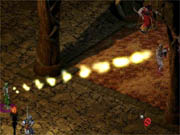
The ranger is the ranged specialist in Pool of Radiance, but like the Icewind Dale hero Drizzt Do'Urden, he can fight with two weapons. The ranger can also use his track ability to identify nearby monsters. Thus, while wandering, your ranger might stop and inform you that he has uncovered zombie tracks, letting you know that it's time to put away the swords and call the cleric to the front of the party.
The paladin is the holy warrior. As such, he can smite evil once per day, giving him a great attack and damage bonus against one evil opponent. The paladin also gets to apply his charisma bonus to his saving throws, making him more resistant to magic attacks and poison. Paladins are also immune to fear, meaning some undead and demons that employ fear attacks can't force paladins to flee like they would to other classes.
Monks are a special class, with some unique spiritual powers. They can move exceptionally fast and can close distance with enemies faster than other classes. They can also heal themselves, have bonuses to resist magic attacks, can dodge energy attacks such as dragon breath weapons and fireballs, can stun opponents with their fists, can resist poisons, and can even kill enemies in one shot with their quivering palm ability.
Sorcerers are a new type of spellcaster in D&D, and players of Baldur's Gate II are no doubt somewhat familiar with this class. They can cast a lot more spells per day and don't need to prepare spells beforehand, but they know only a very limited selection of spells. However, although their selection is limited, they can throw the most powerful offensive spells in the game and do it with alarming frequency. Interestingly, they use charisma--not intelligence--to fuel their powers, as the wizards of the 2nd Edition do.
Clerics are immensely powerful in this game. Unlike in Baldur's Gate II, clerics in Pool of Radiance don't need to select their daily spells from a list before they start adventuring. The benefit here is that a cleric no longer has to anticipate what spells he will need for the day. In Baldur's Gate II, if you thought you were facing traps and would need healing, you would need to select a "find traps" spell and "cure light wounds" spell before you started adventuring. But if you later faced a demon and realized you needed a protection from an evil spell, you would be out of luck because you didn't prepare the spell earlier. In Pool of Radiance, that situation will never happen. Now, the ability to cast any spell without selecting it beforehand gives clerics immense flexibility. Although this ability to cast spells on the fly is not part of the official 3rd Edition rules, Wizards of the Coast--the owners of D&D--have approved this new ability for the cleric.
Final Thoughts
In addition to the new information we discovered in our recent visit to Redstorm's offices, we got a look at some of the new monsters. We saw the arraccats, which are a mix of lion, scorpion, and spider that lays eggs around the corrupting spawn pools. We also saw the stone lizardmen, which are tougher versions of the standard lizardmen and are immune to magic. Yager also showed us the new liches. These powerful undead spellcasters, which have prolonged their lives with magic, haunt the lower dungeons of Myth Drannor. They wield great magic powers, and they can't die unless their phylactery is destroyed. A phylactery houses the lich's spirit, and until you find and destroy it, the lich will keep coming back to undead, no matter how often you destroy its body. Thus, the lich could come back to hunt you down or simply lie in wait for you to return to the dungeons. If you manage to earn the wrath of multiple liches, you could end up being in danger from multiple ambushes every time you delve back into the dungeons.
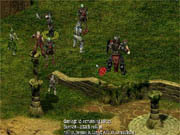
Faithful followers of the 3rd Edition D&D will notice that there will be some deviations from the official rules in Pool of Radiance. Aside from the increased power given to clerics and segregated feats lists, some classes are missing a few abilities. The paladin does not get his warhorse nor immunity to disease, although that's because there are no disease attacks in this game. The thief, for example, no longer gets special abilities at the 10th level, which he does have in the traditional pencil-and-paper rules. Moreover, attacks of opportunities aren't fully implemented, and you can't ready actions. For those who aren't familiar with the new D&D rules, though, these minor rules won't be missed, and the game will just seem like a D&D game with many more options and new abilities.
Pool of Radiance: Ruins of Myth Drannor is shaping up to be a very good role-playing game. It is a nearly faithful conversion of the new 3rd Edition rules and has a lot of traditional role-playing gameplay as well. It should be packed with quests, items, and monsters. And there should be plenty of nonplayer characters, back story, and eye candy to make the game even more interesting. At this point, the game is nearly complete, and barring any last-minute problems or changes, it should release in late June to an eager crowd of RPG fans. From what we've seen, Redstorm and Stormfront Studios should have no problem delivering on their promise of traditional role-playing fun with a faithful rendition of the new D&D rules.
Got a news tip or want to contact us directly? Email news@gamespot.com
Join the conversation